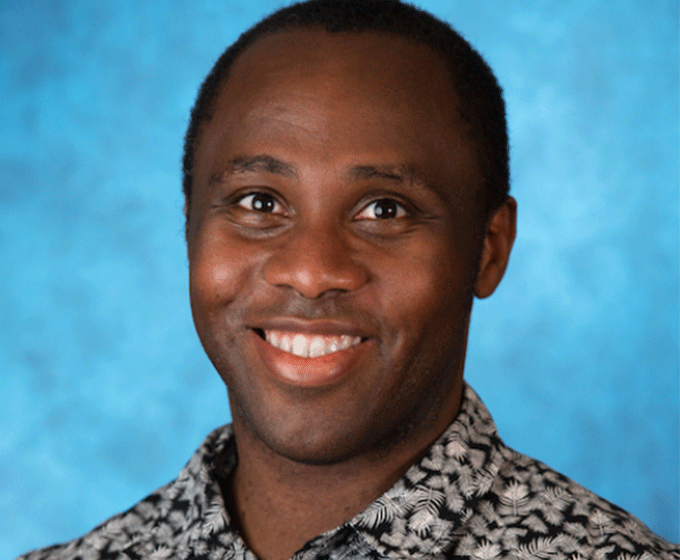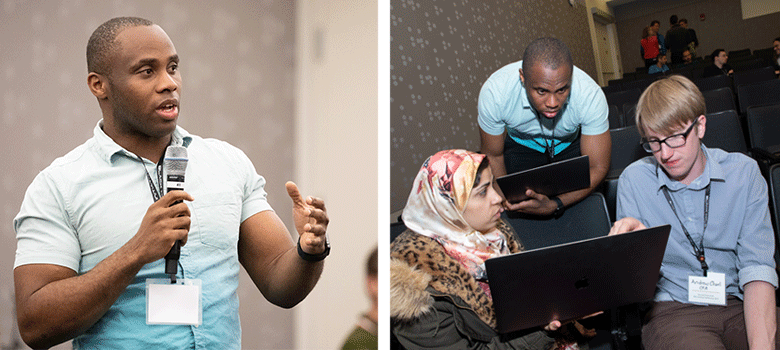
JUNE 8, 2022 — UTSA physics professor Richard Anantua was part of a team of astronomers who recently unveiled the first-ever image of Sagittarius A*, the black hole that sits at the center of the Milky Way galaxy. That team, the Event Horizon Telescope (EHT) Collaboration, is an international research group that uses its worldwide network of radio telescopes and a technique called interferometry to capture high-resolution data as if it were one Earth-size telescope.
This is just the second time in history that a black hole image has been captured. The first image was released in 2019, depicting the black hole at the center of the M87* galaxy.
Anantua, a theoretical astrophysicist in the UTSA College of Sciences, specializes in reverse engineering near-horizon supermassive black hole observations. He modeled and simulated the plasma physics of Sagittarius A* that helped make the image possible.
Anantua sat down with UTSA Today to delve further into black holes and the importance of studying these mysteries that are lightyears away.

Left: UTSA's Richard Anantua speaks at the 2019 Black Hole Initiative Conference. Right: Anantua is pictured with fellow Event Horizon Telescope members Razi Emami and Andrew Chael.
What is a black hole?
RA: A black hole is a region in space that has such an intense gravitational pull that nothing, not even light, can escape it. Supermassive black holes are the largest, with a mass of millions to billions of times the mass of our Sun.
Why are black holes like Sagittarius A* significant to us?
RA: The existence of black holes supports our interpretation of gravity. The image of Sagittarius A* shows light bending near the black hole due to the warping of spacetime by gravity, which proves Einstein’s Theory of General Relativity and further helps us understand how black holes look and behave. Black holes host a type of gravity you don’t encounter in everyday life, they explain gravity as an influence that causes space and time to curve in a certain way and how objects move as well.
This is an important theory that tells us about the fundamental nature of space and time that was thought for many centuries to be absolute. Understanding gravity helps us identify options for the long-term fate of our planet. Sagittarius A* is the supermassive black hole at the center of our Milky Way Galaxy approximately 25,000 lightyears away.
Our galaxy may collide with another galaxy a billion years from now. The laws that govern when and where these collisions will occur are the most important laws of gravity. We can confirm this by looking at how light curves around black holes. Although it’s impossible to travel such distances, even in several human lifespans, the Sagittarius A* image may unlock aspects of the fundamental nature of gravity that enable us to create shortcuts such as wormholes that expedite trans- or inter-galactic journeys.
What’s the larger importance of this research?
RA: It’s the point of existing. There are some people who care about their legacy and the generations that come after them. It’s a good tendency to care about what the fundamental workings of our system are and the way the universe works. That has helped us build technology and understand how to use nature to do things we find useful. Not everything we discover is within the axis of our current technology but being able to explain things opens up the possibilities.
What’s next for the EHT Collaboration?
RA: We are sharpening our focus to image further and smaller black holes. We’re trying to get more coverage with more telescopes to increase the amount of signal and get a clearer picture. We’re looking to establish telescopes in space rather than just on earth that will enable us to see sharper features of black holes.
How can UTSA students take part in this research?
RA: I am starting the first Event Horizon Telescope group in Texas right here at UTSA, and I'm seeking graduate students to participate in research. Our work will focus on having more types of simulations with more scenarios that help us learn what the content of the matter swirling around the black hole looks like. This will help us make assumptions on how dense and magnetized the material is.
We’d also like to test how fast a black hole is spinning, whether there could be events in which stars that are partially pulled into a black hole could have measurable impact on what we see with the telescope. That’s the type of thing we’re working on from a simulation standpoint. From a mathematical and fundamental physics standpoint, we’ll be looking at the power of the spin from a black hole and the theory of how electromagnetic fields can extract energy from black holes.
UTSA Today is produced by University Communications and Marketing, the official news source of The University of Texas at San Antonio. Send your feedback to news@utsa.edu. Keep up-to-date on UTSA news by visiting UTSA Today. Connect with UTSA online at Facebook, Twitter, Youtube and Instagram.
Move In To COLFA is strongly recommended for new students in COLFA. It gives you the chance to learn about the Student Success Center, campus resources and meet new friends!
Academic Classroom: Lecture Hall (MH 2.01.10,) McKinney Humanities BldgWe invite you to join us for Birds Up! Downtown, an exciting welcome back event designed to connect students with the different departments at the Downtown Campus. Students will have the opportunity to learn about some of the departments on campus, gain access to different resources, and collect some giveaways!
Bill Miller PlazaJoin us for an intimate evening of cocktails, conversation, and culinary inspiration with Pati Jinich, Emmy-nominated chef and James Beard Award-winning author. Enjoy light bites and signature drinks in the warm, modern setting of Mezquite as Pati connects with guests over her passion for Mexican cuisine and storytelling.
Mezquite Restaurant in Pullman Market, 221 Newell Ave., San Antonio 78215From inspired courses to thoughtful pairings and a rich sense of community, the Ven a Comer Signature Dinner is a night of shared meals, shared stories, and unforgettable flavor.
Stable Hall (Pear Brewery), 307 Pearl Pkwy, San Antonio 78215Come and celebrate this year's homecoming at the Downtown Campus with food, games, giveaways, music, and more. We look forward to seeing your Roadrunner Spirit!
Bill Miller PlazaThe University of Texas at San Antonio is dedicated to the advancement of knowledge through research and discovery, teaching and learning, community engagement and public service. As an institution of access and excellence, UTSA embraces multicultural traditions and serves as a center for intellectual and creative resources as well as a catalyst for socioeconomic development and the commercialization of intellectual property - for Texas, the nation and the world.
To be a premier public research university, providing access to educational excellence and preparing citizen leaders for the global environment.
We encourage an environment of dialogue and discovery, where integrity, excellence, respect, collaboration and innovation are fostered.